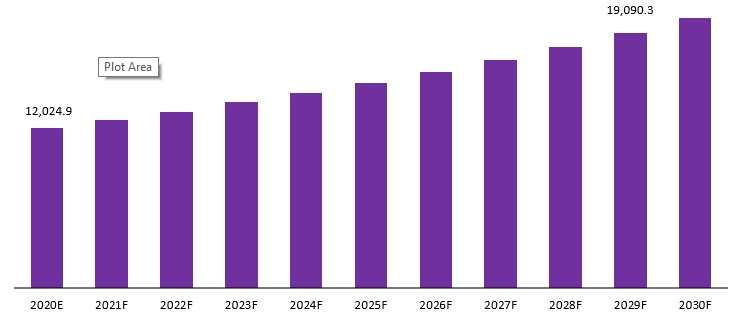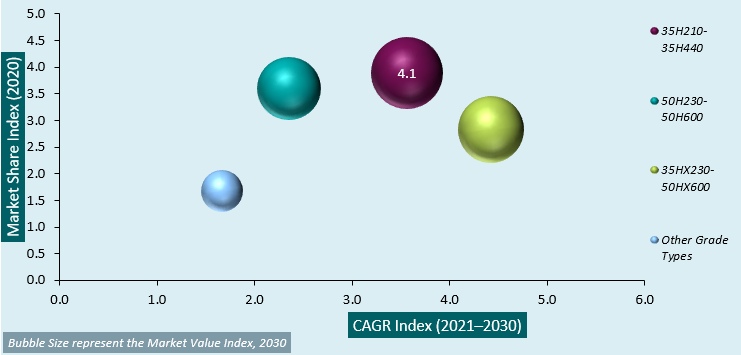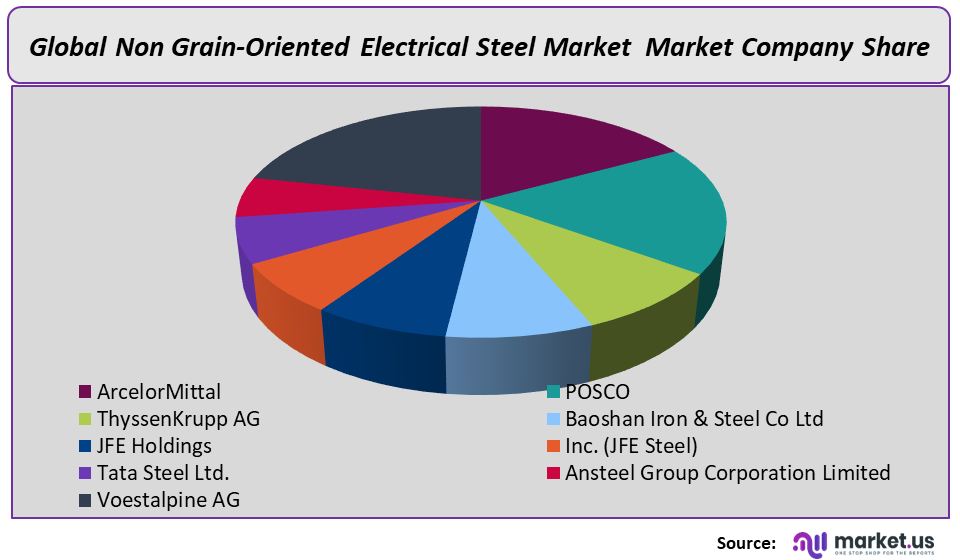Global Non-Grain-Oriented Electrical Steel Market by Grade Type (35H210-35H440, 50H230-50H600, 35HX230-50HX600, Other Grade Types), By Application (Power Generation, Automotive Industry, Household Appliances, Other End-Uses) and by Region and Companies Industry Segment Outlook, Market Assessment, Competition Scenario, Trends and Forecast 2022-2032
- Published date: May 2023
- Report ID: 15054
- Number of Pages: 340
- Format:
- keyboard_arrow_up
Quick Navigation
- Non-Grain-Oriented Electrical Steel Market Overview:
- Global Non-Grain-Oriented Electrical Steel Market Revenue (US$ Mn), 2020–2029
- Global Non-Grain-Oriented Electrical Steel Market Attractiveness Analysis by Non-Grain-Oriented Electrical Steel Grade, 2014–2029
- The research report on the global non-grain-oriented electrical steel market includes profiles of some of the major companies such as
- Global Non-Grain-Oriented Electrical Steel Market Segmentation Based on Grade Type, End-Use, and Region
Non-Grain-Oriented Electrical Steel Market Overview:
The global non-grain-oriented electrical steel market is projected to be USD 12,540.3 Mn in 2022 to reach USD 20,253.5 Mn by 2032 at a CAGR of 5.5%.
Market.US announces the publication of its most recently generated research report titled, “Global Non-Grain-Oriented Electrical Steel Market by Grade Type (35H210-35H440, 50H230-50H600, 35HX230-50HX600, Other Grade Types), By Application (Power Generation, Automotive Industry, Household Appliances, Other End-Uses) and by Region – Global Forecast to 2030”, which offers a holistic view of the global non-grain-oriented electrical steel market through systematic segmentation that covers every aspect of the target market.
Electrical steel has excellent electromagnetic properties, and there are two types: grain-oriented steel and non-grain-oriented electrical steel. Nowadays, as the demand for reducing energy loss has grown exponentially, the demand for high-quality electrical steel has also grown exponentially.
Non-grain-oriented electrical steel has uniform magnetic properties and is used as the core material of rotating machinery, from micro-precision motors to large-scale generators. Non-oriented electrical steel is made of Fe-Si or Fe-Si-Al alloy. They can be fully processed or semi-processed, depending on their grade.
Provide standard grades that can improve the magnetic properties of the final product. This type of electrical steel has superior permeability performance in terms of high induction strength, low average iron loss, and good specification uniformity.
In addition, cold finishing and strip annealing can produce a smooth surface with excellent flatness and increased high-viscosity elements.
From the simplest household appliances to hybrid electric vehicles, it has been integrated into a variety of devices. Other applications include its incorporation into generators, high-efficiency motors, large and small transformers, ignition coils, and lighting ballasts.
Global Non-Grain-Oriented Electrical Steel Market Revenue (US$ Mn), 2020–2029

The power generation and transmission sectors in any region play a pivotal role in supplying power to end-users. The growth of the power sector and the development of strong and unfoldable transmission infrastructure has led to the demand for non-oriented electrical steel.
In addition, due to the development of the infrastructure sector in developing countries, the demand for construction and building materials continues to increase.
Governments’ initiatives to supply electricity to remote or underdeveloped areas are expected to further support the growth of the global non-grain-oriented electrical steel market.
The implementation of the European emission standard Euro VI has increased the cost of diesel powertrains, resulting in a decline in the share of diesel vehicles in Europe.
Similarly, after the Volkswagen emissions scandal (also known as diesel gate or emission gate), global demand for diesel vehicles is declining, thereby reducing the demand for non-grain-oriented electrical steel. This is a factor that is expected to limit the growth of the target market.
Global Non-Grain-Oriented Electrical Steel Market Attractiveness Analysis by Non-Grain-Oriented Electrical Steel Grade, 2014–2029

The global non-grain-oriented electrical steel market is segmented on the basis of grade type, end-use, as well as regions & countries. Based on grade type, the global non-grain-oriented electrical steel market is segmented into – 35H210-35H440, 50H230-50H600, 35HX230-50HX600, and other grade types.
Among the grade type segments, the 35H210-35H440 segment is expected to account for the majority revenue share of this target market. In terms of end-use, the global non-grain-oriented electrical steel market is segmented into – power generation, automotive applications, household appliances, and other end-uses.
The automotive industry is further segmented into – electric vehicles and non-electric vehicles. Among these end-uses, the automotive industry segment is expected to register significant growth in terms of revenue and is projected to grow rapidly over the forecast period.
This can be attributed to the expected increase in the demand for non-grain-oriented electrical steel in electric vehicles over the next few years. On the basis of region, the global non-grain-oriented electrical steel market is segmented into – North America, Europe, Asia Pacific, South America, and the Middle East & Africa.
Among these, the markets in the Asia Pacific region are projected to register a significant spike in revenue shares, due to the increasing demand for non-grain-oriented electrical steel in varying applications, coupled with the presence of prominent manufacturers in this region.
The research report on the global non-grain-oriented electrical steel market includes profiles of some of the major companies such as
- ArcelorMittal
- POSCO
- ThyssenKrupp AG
- Baoshan Iron & Steel Co Ltd
- JFE Holdings
- Inc. (JFE Steel)
- Tata Steel Ltd.
- Ansteel Group Corporation Limited
- Voestalpine AG
- Aperam S.A.
- and Cleveland-Cliffs
- Inc. (AK Steel Holding Corporation)
- and others.

Global Non-Grain-Oriented Electrical Steel Market Segmentation Based on Grade Type, End-Use, and Region
Based on Grade Type
- 35H210-35H440
- 50H230-50H600
- 35HX230-50HX600
- Other Grade Types
Based on End-Use
- Power Generation
- Automotive Industry
- Electric Vehicle
- Non-Electric Vehicle
- Household Appliances
- Other End-Uses
Based on Region
- North America
- Europe
- Asia Pacific
- South America
- Middle East & Africa
For the Non-Grain-oriented Electrical Steel Market research study, the following years have been considered to estimate the market size:
Attribute Report Details Historical Years
2016-2020
Base Year
2021
Estimated Year
2022
Short Term Projection Year
2028
Projected Year
2023
Long Term Projection Year
2032
Report Coverage
Competitive Landscape, Revenue analysis, Company Share Analysis, Manufacturers Analysis, Volume by Manufacturers, Key Segments, Key company analysis, Market Trends, Distribution Channel, Market Dynamics, COVID-19 Impact Analysis, strategy for existing players to grab maximum market share, and more.
Regional Scope
North America, Europe, Asia-Pacific, South America, Middle East & Africa
Country Scope
United States, Canada and Mexico, Germany, France, UK, Russia and Italy, China, Japan, Korea, India and Southeast Asia, Brazil, Argentina, Colombia etc.Saudi Arabia, UAE, Egypt, Nigeria and South Africa
 Non Grain-oriented Electrical Steel MarketPublished date: May 2023add_shopping_cartBuy Now get_appDownload Sample
Non Grain-oriented Electrical Steel MarketPublished date: May 2023add_shopping_cartBuy Now get_appDownload Sample - ArcelorMittal SA Company Profile
- POSCO
- ThyssenKrupp AG Company Profile
- Baoshan Iron & Steel Co Ltd
- JFE Holdings
- Inc. (JFE Steel)
- Tata Steel Ltd. Company Profile
- Ansteel Group Corporation Limited
- Voestalpine AG
- Aperam S.A.
- and Cleveland-Cliffs
- Inc. (AK Steel Holding Corporation)
- and others.
- settingsSettings
Our Clients
| Single User $4,599 $3,499 USD / per unit save 24% | Multi User $5,999 $4,299 USD / per unit save 28% | Corporate User $7,299 $4,999 USD / per unit save 32% | |
|---|---|---|---|
| e-Access | |||
| Report Library Access | |||
| Data Set (Excel) | |||
| Company Profile Library Access | |||
| Interactive Dashboard | |||
| Free Custumization | No | up to 10 hrs work | up to 30 hrs work |
| Accessibility | 1 User | 2-5 User | Unlimited |
| Analyst Support | up to 20 hrs | up to 40 hrs | up to 50 hrs |
| Benefit | Up to 20% off on next purchase | Up to 25% off on next purchase | Up to 30% off on next purchase |
| Buy Now ($ 3,499) | Buy Now ($ 4,299) | Buy Now ($ 4,999) |











